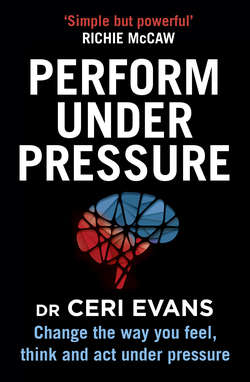Читать книгу Performance Under Pressure - Ceri Evans - Страница 31
Chapter 3, Balanced Brain vs Unbalanced Brain
ОглавлениеOur emotional regulation system sits at the heart of our performance under pressure.
Our RED system evolved through repeated connections with our primary caregivers, and this determines how much feeling we can tolerate and how flexible our responses are when we become uncomfortable.
Far from being a wishy-washy system of feelings and sensations, the RED system is the primary driver of our psychological reaction in pressure situations. Our emotional blueprint – laid down in our first two years and constantly revised through life experience – has a lot to do with how we respond to pressure, and whether we become prone to unhelpful behaviours. When our emotional regulation is poor and RED dominates, our attention becomes divided or diluted and our focus is dragged away from the present moment. We lose emotional flexibility and the ability to think clearly and our behaviours default to basic survival instincts, out of keeping with the situation.
In my experience the most commonly identified pattern is for performance under pressure to cause over-arousal – too much RED – rather than under-arousal. But one trap is to assume that under-arousal comes from too little emotion, when in fact it often comes from too much anxiety and tension and a partial freeze reaction. Going ‘flat’ can look relaxed, but is actually very different – and is sure to lead to poor performance.
Trying to ignore or suppress our RED mind is a weak strategy, because it has evolved to never be snubbed or shut down. In fact, trying to overlook it actually powers up our RED response until it gets our attention. If need be, it will take over and make its presence felt.
But whatever template we have now does not fully determine how we respond to pressure. Our BLUE system is designed to exert some control over the feelings and impulses that emerge when we are emotionally uncomfortable. Our BLUE mind can kick in to provide balance and control of our RED system, and we can get the two systems back in sync.
Our BLUE system controls RED emotion first of all by naming it – remember our left hemisphere has the power of language – and simply naming a vague, hard-to-describe physical experience has a very settling effect. Our BLUE system can then reappraise the situation by focusing on the negative experience and modifying its meaning. Left-brain naming and meaning-change dampen down the RED emotional intensity.
It’s important to remember that the RED system is not inherently good or bad, any more than emotions are good or bad. Our feelings are a normal and essential part of life. Without them we would never experience the joy of close connections or the thrill of chasing goals and achieving them. The RED emotional system is what gives us drive and energy; it gets us going. It’s just when RED goes into overdrive and we lose control that we meet problems.
It would be a serious mistake to label RED as bad and BLUE as good. Both systems are very useful for their intended purposes. Too much RED may be more common, but being too BLUE can be just as harmful to performance. It can cause us to lose emotional connection, becoming detached, aloof and even cold. Team spirit would be impossible within a completely BLUE world.
This book is fundamentally about finding our RED–BLUE balance, not about casting RED as a villain and BLUE as the hero of the piece.
My aim is to help you perform effectively when you’re out of sorts and stressed, not when it’s plain sailing. As we’ve learned, under pressure we will experience discomfort, so we need to learn to be comfortable being uncomfortable – not just coping with discomfort, but thriving within it.
How well we perform depends on the quality of our attention. And our control of attention is driven by the interaction between our RED and BLUE mind systems.
Whether RED and BLUE are in sync or out of sync will have a large say in whether we can perform under pressure. If we are badly prepared, pressure can take us down. If we are well prepared, pressure can lift us up to new heights.
In this chapter, I’ll look at the most common ineffective patterns of feeling, thinking and acting under pressure, and contrast them with the most common effective patterns of feeling, thinking and behaving under pressure. Understanding these patterns provides us with a better chance of detecting when we are going off track, and more idea of how to get back on track once it happens.
